- Ventilation, Circulation, Temperature, Humidity, and CO2
- Air Ventilation
- Exhaust and Air Circulation
- Types of Ventilation Fans
- Air Circulation
- Air Ducting
- Controlling Temperature and Humidity
- Monitoring Temperature and Humidity
- Carbon Dioxide (CO2) Enrichment
- CO2 Emitter Systems
- CO2 Generator Systems
- Odor Control
- Masking Agents for Odor Control
- How to Activated Carbon Filters
- Additional Considerations for Carbon Filters
- CO2 and Fragrance Management
- Effective Air Circulation
- Useful links
- Subscribe to the newsletter
Ventilation, Circulation, Temperature, Humidity, and CO2
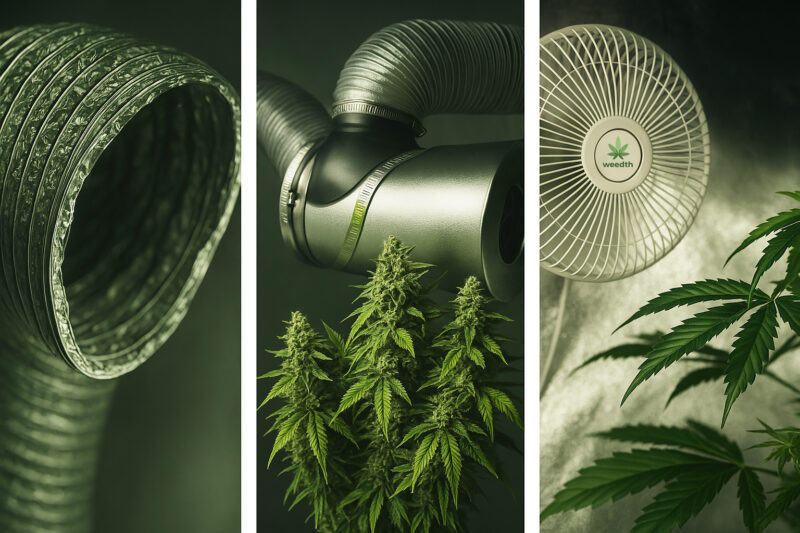
Ventilation is critical to maintaining a healthy and productive indoor garden. Fresh air is necessary for all grow spaces, and it’s easy to obtain and relatively inexpensive to maintain. Proper air ventilation often makes the difference between a successful, heavy harvest and complete crop failure. Fresh air brings in carbon dioxide (CO2), which is essential for plant life. At the same time, a good ventilation system expels air that’s low in CO2, helping maintain the right balance for photosynthesis.
In addition to supplying CO2, air ventilation is crucial for keeping temperature and humidity at optimal levels for fast, healthy plant growth. Both intake and exhaust vents are needed to ensure proper airflow in and out of the grow space. Circulation fans are equally important for preventing stagnant air, which can lead to hot and cold stratification—when warm air rises and cool air stays near the floor—making temperature control difficult. Proper airflow also helps prevent mold and mildew by reducing excess moisture in the air.
Air Ventilation
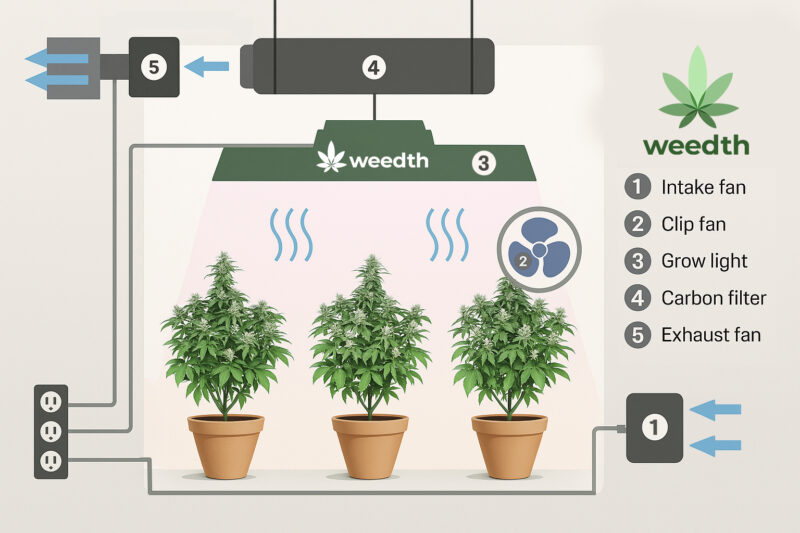
To effectively vent warm air out of the room, install air exit vents in the hottest part of the grow space, usually at the highest point, since hot air naturally rises. This method allows for passive, silent air ventilation. The larger the diameter of the exhaust ducts, the more air can be moved out of the room. However, passive air vents alone may not provide sufficient airflow. In this case, an exhaust fan can be added to accelerate air movement, helping maintain the proper environment for the plants.
A fresh air intake vent is equally essential to create a consistent flow of air into the room. This intake vent could be as simple as cracks in the walls, a gap under the door, or a proper louvered vent. Whatever the form, it must be large enough to allow enough air to enter the space to keep the air exchange balanced. Ideally, intake vents should be placed near the floor to draw in cooler air from outside. When paired with an exhaust fan that pulls air out of the room, this setup helps maintain a constant flow of fresh air.
In some cases, passive intake may not provide enough airflow, especially in tightly sealed grow rooms. If passive airflow is insufficient, attaching a fan to the intake vent will help draw air in more effectively. Creating a slight vacuum inside the grow room is ideal for proper air circulation. This slight negative pressure keeps doors closed naturally and ensures a steady flow of fresh air into the space. A common rule of thumb is to maintain a 1:4 ratio—for example, 100 cubic feet per minute (CFM) of incoming air and 400 CFM of outgoing air. This ratio maintains negative pressure in the room, keeping the environment balanced.
The fresh air entering the room should be close to the same temperature as the air already inside to avoid temperature shock for the plants. Cover intake vents with fine mesh screens to block pests from entering the grow space, reducing the risk of infestations.
Exhaust and Air Circulation
Every grow space needs either an exhaust vent or an extraction fan to ensure proper air exchange. The air in the grow room should be replaced every 1-5 minutes, depending on the size of the space. Smaller grow rooms should aim for faster air exchange, with the air changing every minute to maintain optimal growing conditions. A well-installed vent fan can pull air out of a room up to four times more efficiently than a fan that pushes air out.
Exhaust fans are rated by their capacity to move air, measured in cubic feet per minute (CFM) or cubic meters per hour (m³/h). The fan should be capable of replacing the air in the grow room in 1-5 minutes. For example, a grow room that measures 4 x 4 feet (1.2 x 1.2 meters) requires a fan with a rating of 100 CFM (170 m³/h) to exchange the air properly. Larger grow spaces will naturally require more powerful fans.
Axia fans are often preferred to ensure quiet and efficient air movement. These fans are quieter and more efficient when properly installed, and they can be connected to a rheostat (a fader switch) or thermostat for precise control. By adjusting fan speed to meet the needs of the grow room, noise can be minimized while maintaining a stable temperature of around 75°F (24°C) during the day and 70°F (21°C) at night.
For optimal ventilation, aim to have four times more air exiting the room than entering it. This creates a slight vacuum that maintains a steady flow of fresh air while keeping the doors closed naturally.
Types of Ventilation Fans
Exhaust or extraction fans come in various styles and sizes. They are usually rated by how much air they can move in cubic feet per minute (CFM) or cubic meters per hour (m³/h). For example, a 5 x 5-foot grow room might need a 150 CFM (255 m³/h) fan to maintain adequate airflow. Below is a general guide for fan sizing based on grow room dimensions:
| Room Size | Fan CFM (m³/h) |
|---|---|
| 2 x 2 ft (60 x 90 cm) | 40 (68) |
| 3 x 3 ft (90 x 90 cm) | 60 (102) |
| 4 x 4 ft (1.2 x 1.2 m) | 100 (170) |
| 5 x 5 ft (1.5 x 1.5 m) | 150 (255) |
| 6 x 6 ft (1.8 x 1.8 m) | 250 (425) |
| 7 x 7 ft (2.1 x 2.1 m) | 400 (680) |
| 8 x 8 ft (2.4 x 2.4 m) | 500 (850) |
Squirrel cage fans are popular for grow rooms due to their efficiency and ability to move large volumes of air. Propeller or muffin fans with large blades can expel air through large openings, making them quiet and efficient when balanced and operated at low RPM. Inline fans are often used for more compact spaces, designed to fit into ducting for easy installation and efficient airflow. These fans feature propellers that quickly and quietly move air through the ventilation system.
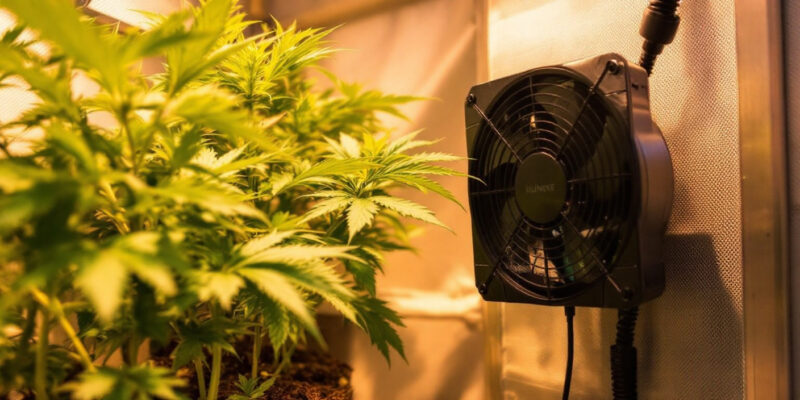
Some growers also use high-speed computer fans for smaller grow spaces. These fans are quiet, compact, and surprisingly efficient for their size, making them ideal for micro-grows or smaller rooms that need a little extra airflow.
Air Circulation
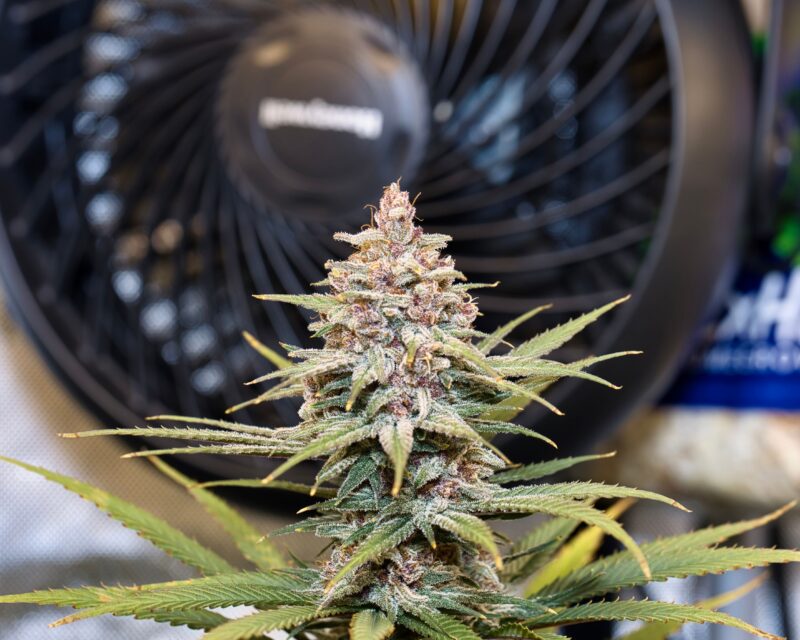
In any indoor grow room, air circulation is a important for creating an environment where cannabis plants can thrive. Proper circulation ensures that the air within the grow space is constantly moving, helping to prevent stagnant zones where heat, humidity, or even CO2 levels can build up unevenly. An oscillating circulation fan is the most common and effective way to achieve this. It helps maintain an even distribution of air, ensuring that all parts of the plant receive fresh air and that temperature and humidity levels remain consistent throughout the room.
Mounting at least one 12- to 16-inch (30-40 cm) oscillating fan for every 400-600 watts of light is recommended to maintain optimal air movement. These fans should be mounted on walls or ceilings, keeping them off the floor to save space and reduce the risk of tripping hazards or damage to equipment. When mounting the fans, ensure they are positioned far enough away from the plants so that the airflow causes the leaves to flutter slightly. This gentle movement is enough to simulate the natural breeze plants would experience outdoors, promoting strong stems and healthy growth without causing damage.
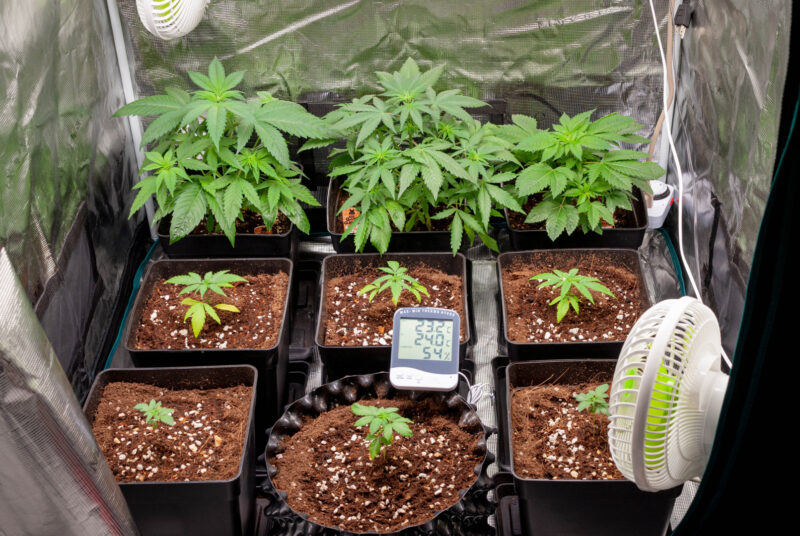
If fans are placed too close or are blowing too hard, they can cause windburn, which results in leaves drying out, curling, or becoming damaged, particularly on tender seedlings or clones. Windburn can severely stress young plants, stunting their growth and even causing leaf death. To avoid this, make sure that fans are always oscillating to provide gentle, non-concentrated airflow. By moving the air evenly across the plants, the fan will prevent hot spots from developing and reduce the risk of moisture buildup, which could otherwise lead to mold and mildew issues.
For long-term use, it’s a good idea to remove the outer shroud from oscillating fans with plastic blades. This reduces resistance on the motor, allowing the fan to operate more smoothly and extending its lifespan. With less strain on the motor, the risk of overheating or fire is significantly reduced. However, always be mindful of safety when modifying equipment and ensure that the fan still operates effectively after the adjustment.
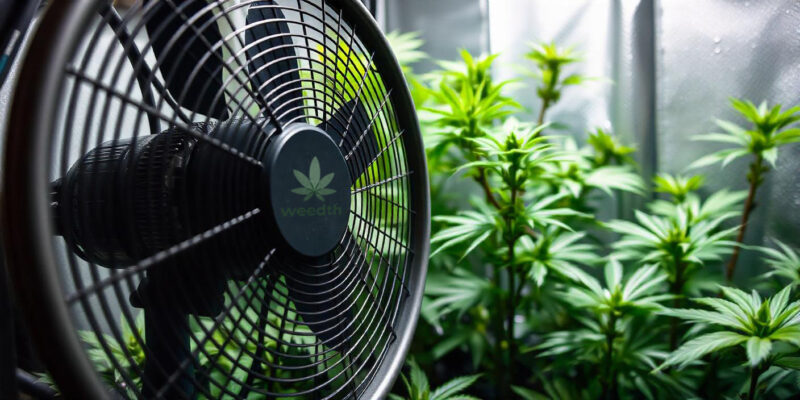
In smaller grow spaces, oscillating fans mounted to walls or ceilings are particularly effective because they save space and can be easily directed to move air where it is needed most. For added efficiency, place felt or rubber grommets beneath the fan’s mounting points to reduce vibration and noise. Vibration can create unnecessary noise, especially in small rooms, which can be distracting and disrupt the environment. Reducing this noise while maintaining effective air movement helps create a more comfortable grow space for both the plants and the grower.
Air Ducting

Proper ventilation in a grow room often requires ducting to direct stale, hot air out of the space while bringing in fresh, cooler air. Ducting connects vent fans to the outside or another venting location and should be kept as straight and short as possible to maximize airflow efficiency. Flexible ducting is easier to install than rigid ducting, but it’s important to minimize sharp bends and long stretches. Every bend over 30 degrees significantly reduces the efficiency of the airflow, slowing down the rate at which air is expelled from the grow space.
Ideally, used air from the grow room should be vented out through a chimney, roof vent, or window. This keeps the telltale smell of cannabis from building up inside the grow room or leaking into surrounding areas, which can be a concern for growers in populated or residential areas. By directing the used air away from neighbors and common areas, you can reduce the risk of drawing attention to the grow operation and avoid any potential complaints or security issues.
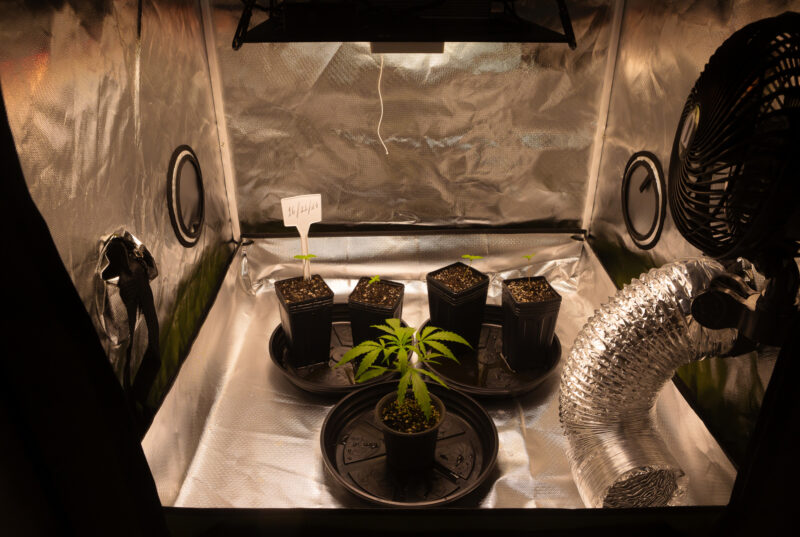
For maximum efficiency, keep the ducting short and direct. The longer the ducting run and the more bends it contains, the slower the air will move, reducing the overall effectiveness of your ventilation system. This can lead to increased temperatures and humidity levels inside the grow room, which could harm the plants. Proper ducting is crucial for maintaining optimal growing conditions and preventing heat buildup.
Controlling Temperature and Humidity
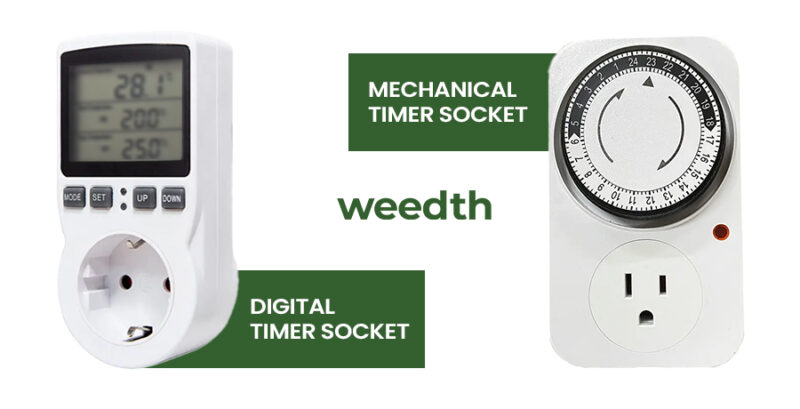
Managing the grow room environment effectively often requires more than just ventilation and manual adjustments. Automated controllers, available at most hydroponic stores, make it much easier to regulate the atmosphere inside your grow space. These controllers allow growers to set specific temperature and humidity parameters, enabling the system to automatically adjust ventilation, heating, or cooling equipment as needed to maintain the desired environment.
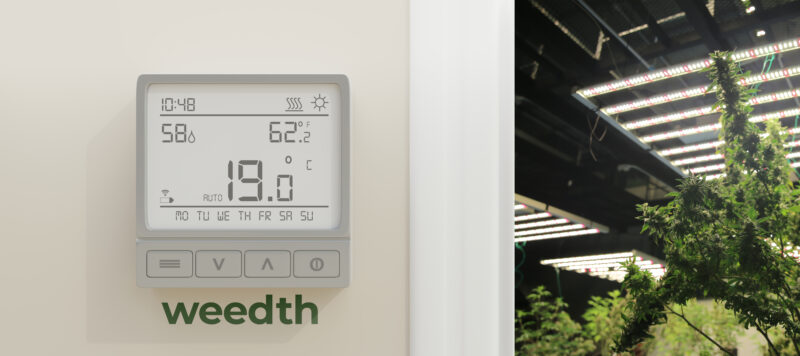
Many of these controllers are designed with built-in thermostats and humidistats, which continuously monitor the grow room conditions and activate fans, air conditioners, or heaters to keep everything within the optimal range. Some systems come with timers that can synchronize air circulation with the lighting schedule, ensuring the temperature and airflow are properly regulated when the lights are at their hottest or during the cooler night periods.
A standard heat pump or air conditioner thermostat often uses a simple mechanism to detect and control temperature. Inside the unit, a liquid mercury bubble moves within a small glass tube. As the temperature rises or falls, the bubble shifts position, triggering the system to either cool or heat the room. While this technology is effective for basic temperature control, modern grow room controllers offer far more precision and automation.

These more advanced systems feature digital displays, making it easy for growers to adjust settings and monitor real-time data. With the use of remote sensors, some controllers can even detect variations in temperature and humidity throughout different parts of the grow room, allowing for highly accurate environmental control. This eliminates the need for constant manual intervention, which can be both time-consuming and inconsistent.
By automating the management of the grow room’s atmosphere, growers can focus on other important tasks, knowing that their plants are being cared for in a stable, controlled environment. This not only improves plant health and yield but also reduces the risk of human error in maintaining the right conditions.
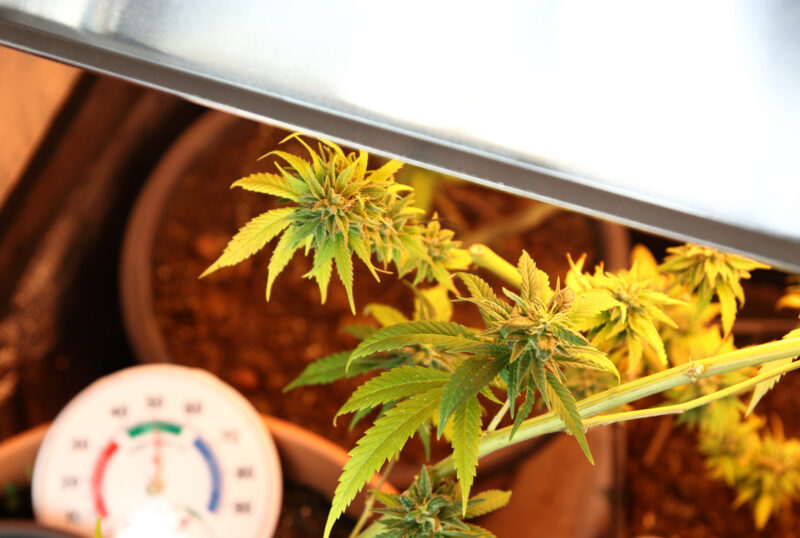
Using a combination of automatic controllers and a maximum/minimum thermometer and hygrometer allows for close monitoring of both day and night temperatures. It’s a good practice to place these monitoring tools in key locations within the grow space—such as at canopy level, near the floor, and at the ceiling—to get a full understanding of how temperature and humidity fluctuate throughout the room. Taking readings regularly ensures that your automatic controllers are working correctly and maintaining the ideal conditions for your cannabis plants.
You can regulate the temperature and humidity in the room by using vent fans, heaters, and air conditioners. If your grow room has built-in HVAC vents, use them to supply extra heat or cool air as needed, but always ensure there is enough air exchange to prevent humidity from building up or temperatures from spiking. Ventilation fans are the main tool for controlling temperature and humidity, but rheostats or thermostats can be added to give precise control over the airflow.
Monitoring Temperature and Humidity
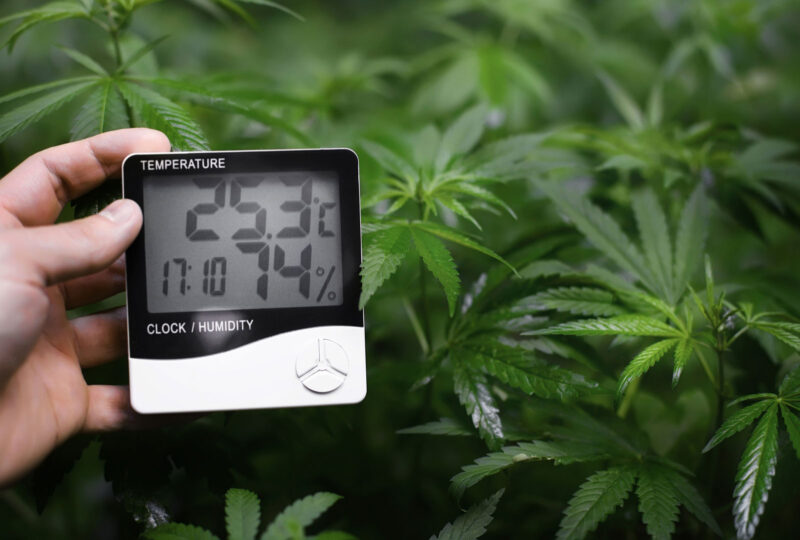
Accurate monitoring of the grow room environment is essential for ensuring that the plants are growing under optimal conditions. Installing maximum/minimum thermometers and hygrometers at different points in the room allows for precise temperature and humidity readings throughout the grow cycle. Ideally, place one thermometer near the ceiling (where the hottest air accumulates), one at the canopy level of the plants, and another near the floor. This setup allows for a complete picture of the environmental conditions at different levels in the grow room.
Take readings at several key points during the day:
- Before the lights turn on – to see the room’s lowest temperature.
- During the hottest part of the day – when the lights are at their peak heat output.
- 30 minutes after the lights go off, gauge how quickly the room cools down.
By recording these temperature and humidity readings regularly, you can spot trends and adjust your system to maintain optimal conditions for your plants. For even greater accuracy and control, consider using a digital thermostat or humidistat that can be connected to the ventilation system to automatically turn fans or heaters on and off as needed. This helps keep the room within the proper range without constant manual adjustment.
Carbon Dioxide (CO2) Enrichment
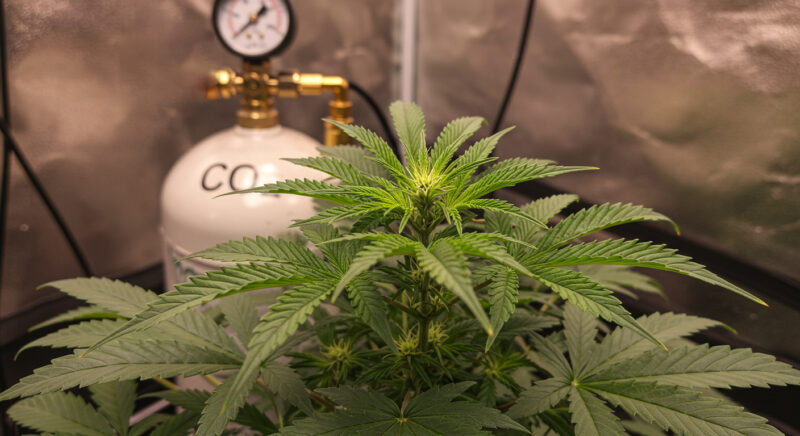
Cannabis plants can utilize significantly more CO2 than the typical 0.04 percent (400 ppm) naturally found in the atmosphere. By increasing the concentration of CO2 in the grow room to around 0.12-0.15 percent (1200-1500 ppm), plants can grow up to 30 percent faster, provided that other factors like light, water, nutrients, and genetics are not limiting. This boost in growth rate makes CO2 enrichment an attractive option for indoor growers aiming to maximize yield and plant health. However, CO2 levels above 5000 ppm are not safe for humans, so it’s essential to monitor levels carefully.
When enriching CO2, plants will also consume nutrients, water, and space more rapidly, which means growers need to stay on top of their plants’ needs. A higher grow room temperature, typically between 75°F to 80°F (24°C to 27°C), can help stimulate faster metabolism in the plants, enabling them to make the most of the increased CO2 levels. The combination of higher temperatures and enriched CO2 can lead to vigorous growth, but growers must ensure that all other environmental factors remain optimal.
CO2 levels can be monitored in several ways. Inexpensive disposable CO2 tests are available, but they only provide a one-time reading. For more precise control, investing in an infrared CO2 monitoring system is highly recommended. These systems provide real-time data on CO2 levels and help maintain a stable environment. For automatic control, electronic devices are available that regulate CO2 levels, turning emitters on or off as needed to maintain the desired concentration in the grow room.
CO2 Emitter Systems
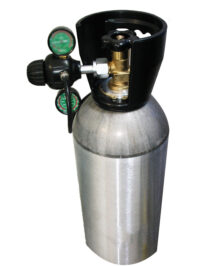
CO2 emitter systems are a popular choice among indoor growers because they produce no toxic gases, water, or heat, which could otherwise disrupt the carefully controlled environment of a grow room. These systems work by metering an exact amount of CO2 from a compressed gas cylinder into the room, ensuring precise control over CO2 levels.
Purchasing a complete CO2 emitter system from a hydroponics store is often the best option for small-scale indoor growers. These systems are easy to install and offer consistent results. They typically consist of a CO2 tank, regulator, and emitter that work together to release controlled amounts of CO2 into the air.
CO2 tanks are available in various sizes to suit different growing needs. A full 50-pound steel tank weighs 170 pounds (77 kg), while a full 20-pound steel tank weighs 70 pounds (32 kg). For those seeking a lighter option, 20-pound aluminum tanks weigh about 50 pounds (23 kg) when full, and a full 35-pound aluminum tank weighs 75 pounds (34 kg). Most suppliers offer tank exchange and refill services, making it easy to maintain a steady supply of CO2. These tanks are also inspected annually for safety to ensure they remain in good condition.
When CO2 is released, it is extremely cold and sinks to the ground due to being heavier than air. This means it will naturally cascade down onto the plants below. To prevent the CO2 from pooling at the bottom of the grow room and to ensure even distribution throughout the space, a good air circulation system is essential. Without proper circulation, the CO2 won’t reach the upper parts of the plants, and its benefits could be lost.
CO2 Generator Systems
For larger operations or growers looking for a more cost-effective method, CO2 generator systems offer a viable alternative to emitter systems. These systems burn natural gas or liquefied propane (LP) gas to produce CO2. While they are generally less expensive to operate than emitter systems, they come with a few downsides—namely, they generate heat and water as byproducts of the combustion process. The additional heat can make it more challenging to maintain the correct temperature in the grow room, particularly if the space is already on the warmer side. The excess moisture can also raise humidity levels, which may lead to mold or mildew problems if not properly managed.
CO2 generators use a pilot light, flow meter, and burner enclosed in protective housing. These components ensure that the CO2 is released at a controlled rate, keeping the concentration in the grow room within the desired range. The system can be operated manually or synchronized with a timer that works alongside other grow room equipment, such as ventilation fans. This ensures that the CO2 release is timed with the plants’ light cycle, maximizing the benefits of enrichment.
Because CO2 is heavier than air, it tends to settle toward the bottom of the grow room. To distribute the CO2 evenly, good air circulation is critical. Without it, the CO2 could remain concentrated near the ground, depriving the upper parts of the plants of this valuable resource. Proper circulation ensures that all parts of the plant receive the CO2 they need for enhanced photosynthesis and growth.
Odor Control
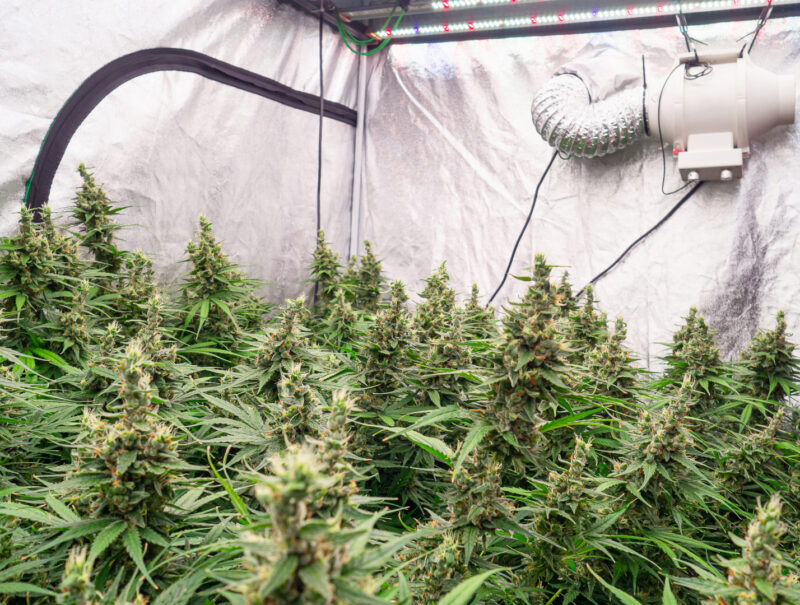
As cannabis plants mature, especially during the flowering stage, they produce a potent fragrance that becomes significantly more intense as the plants approach harvest. This smell, while pleasant to cannabis enthusiasts, can be overwhelming and attract unwanted attention if not properly controlled. Before flowering, many strains produce only a mild scent, which can be managed with basic ventilation. However, once flowering begins, the aroma can quickly overpower a space, and simple exhaust fans may not be enough to control the smell. Managing this fragrance is crucial, especially for those growing in urban or residential areas where discretion is important.
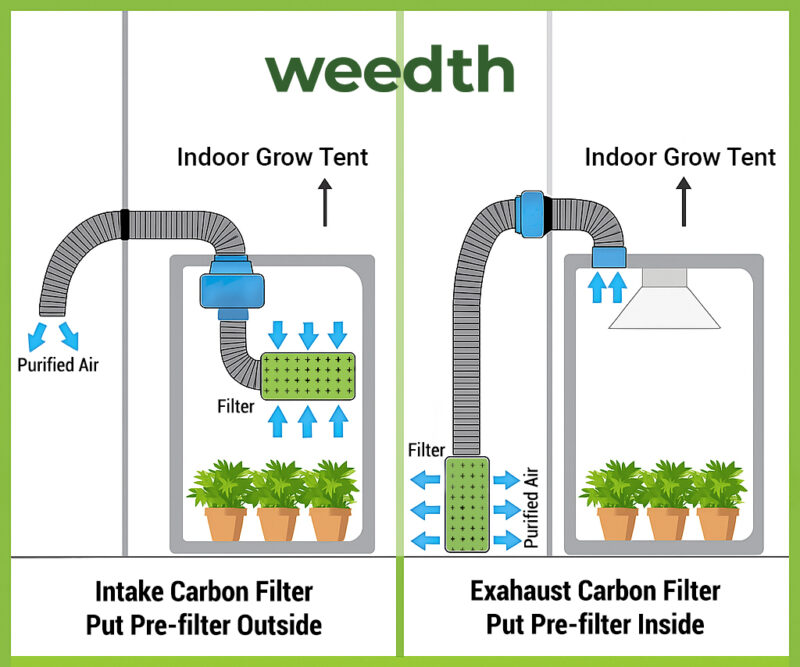
The first and most essential step in odor control is having a good exhaust fan that vents air outdoors. Venting air outside helps to minimize the spread of cannabis odors within the house. However, as the scent intensifies, growers must take additional steps to ensure their indoor garden remains discreet. Effective odor control involves a combination of masking agents, carbon filters, and air circulation systems to neutralize and eliminate the smell of cannabis as it’s vented out of the grow room.
Masking Agents for Odor Control

Masking agents are a popular and easily accessible solution for neutralizing odors in specific areas. These products work by altering the air on an atomic level, effectively neutralizing or covering up strong smells. Most masking agents come in the form of essential oil-based gels or sprays that can be placed strategically around the grow space, at entryways, or near exhaust exits. The deodorizers release odor-neutralizing particles that help mask the strong smell of cannabis, replacing it with a more neutral or pleasant scent.
Gels are slow-releasing and can be placed in areas that require ongoing odor control, such as hallways, near doors, and around air vents. On the other hand, sprays provide a quick fix, neutralizing strong odors instantly when the need arises. Many masking agents contain essential oils like lavender, citrus, or pine, which not only mask the cannabis smell but also create a fresher environment.
Some more advanced products are designed to integrate directly into the grow room’s ventilation ducting system. These specialized deodorizing units attach to the ductwork and release neutralizing agents as the air moves through, effectively treating the odor at the source before it is expelled outdoors. This can be especially useful for keeping exhaust odors under control, ensuring that neighbors or passersby are not exposed to the distinct fragrance of cannabis.
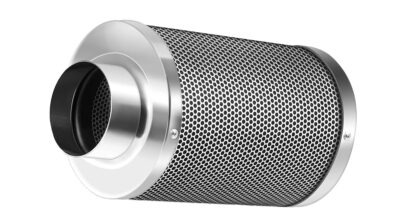
While masking agents are effective in temporarily reducing strong smells, they are generally not sufficient for completely eliminating cannabis odors, especially during heavy flowering. To ensure comprehensive odor control, these products should be used in conjunction with more permanent solutions like activated carbon filters.
How to Activated Carbon Filters
Humidity must be below 55 percent
Carbon filters are sensitive to moisture. If the relative humidity in the grow room exceeds 65-70 percent, the charcoal absorbs moisture instead of odor molecules, clogging the filter and significantly reducing its effectiveness. Maintaining proper humidity levels is critical not only for plant health but also for ensuring the carbon filter works as intended. Dehumidifiers or air conditioners may be necessary in particularly humid climates to keep humidity in check.
Air must move slowly through the carbon filter
To efficiently extract odors from the air, it’s important that air flows through the filter at a controlled rate. If the air moves too quickly, the filter won’t have enough time to trap the odor molecules, resulting in incomplete odor removal. Adjusting the speed of your exhaust fan can help ensure that air is moving through the filter at the optimal rate, allowing the carbon to absorb as many odor particles as possible.
A pre-filter should be used to remove dust
Carbon filters are designed to absorb odors, not debris or dust particles. A pre-filter helps remove dust from the air before it passes through the carbon, ensuring the filter remains unclogged and functional. Pre-filters should be changed every 60 days to keep the system working efficiently.
Important: If dust accumulates in the carbon filter, it can block airflow and reduce the filter’s lifespan.
When set up correctly, activated carbon filters can handle even the most pungent cannabis odors, providing a long-term solution for odor control. They are available in various sizes and can be fitted to most exhaust systems, making them versatile enough for grow rooms of any size. Do not use crushed carbon for filtration, as it is less efficient than charcoal pellets, which have a larger surface area and are better at capturing odor molecules.
Additional Considerations for Carbon Filters
Carbon filters do not last indefinitely. Over time, the activated carbon becomes saturated with odor molecules, reducing its ability to absorb new smells. Depending on the filter's size and the growth operation's intensity, filters may need to be replaced every 6-12 months. It’s important to monitor the effectiveness of your filter regularly. If you notice that the smell is starting to escape, it may be time to replace the filter.
In larger grow rooms or commercial operations, it may be necessary to use multiple carbon filters to ensure proper odor control. Install these filters in the main exhaust system and consider adding secondary filters at key locations, such as doors or high-traffic areas, to prevent any odor from escaping into common areas.
CO2 and Fragrance Management
When using CO2 enrichment systems, it’s important to be mindful of how these systems interact with your grow room’s ventilation and odor control methods. CO2 is heavier than air and tends to settle near the bottom of the room. To keep CO2 properly mixed and ensure that all plants are receiving the benefit of the added CO2, you need strong air circulation. At the same time, you must balance this circulation with the use of carbon filters to ensure that odors are not inadvertently vented into unwanted areas.
Effective Air Circulation
A good air circulation system is also crucial for odor control, as it prevents pockets of stagnant air where odors can accumulate. Oscillating fans placed strategically throughout the grow space help to keep air moving evenly, ensuring that the carbon filters can efficiently remove odors from all parts of the room. Without proper air circulation, CO2 and odor molecules can settle in certain areas, reducing the effectiveness of both the CO2 enrichment and the carbon filtration system.



